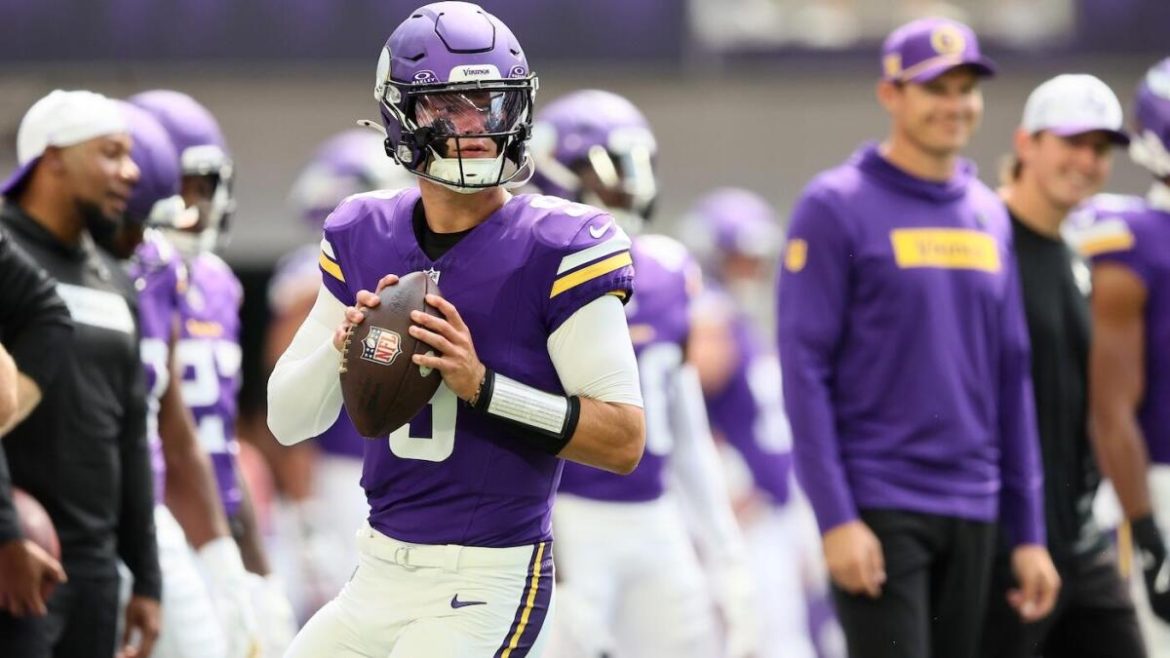The Minnesota Vikings’ quarterback strategy has become a captivating narrative in the NFL offseason, centered on a clear and deliberate three-year plan to build a Super Bowl contender around the young signal-caller J.J. McCarthy. This analysis delves deeply into the Vikings’ decision-making process, their confidence in McCarthy’s potential, and the broader implications of passing on veteran Aaron Rodgers.
A Strategic Commitment to Youth: The Three-Year Super Bowl Window
The overriding theme across reports is that the Vikings are committed to a “three-year window” in which they believe they can contend for the Super Bowl with J.J. McCarthy as their starting quarterback. This timeline reflects a blend of optimism and realism — the franchise views McCarthy, currently entering his second NFL season, as the foundation for sustained success rather than a mere stopgap solution. By anchoring their strategy on a young, up-and-coming QB, the Vikings have chosen a trajectory that balances player development, salary cap management, and roster stability.
Multiple sources confirm that the Vikings rejected high-profile free agent offers for Aaron Rodgers because their front office and coaching staff have faith in McCarthy’s abilities and growth potential. This is underscored by head coach Kevin O’Connell’s public show of confidence and by general manager Kwesi Adofo-Mensah’s endorsement of McCarthy as the QB1 moving forward. With McCarthy being cost-controlled on a rookie-scale contract through much of this window, the Vikings can allocate resources to bolster the roster around him without the financial burden associated with veteran quarterbacks.
Passing on Aaron Rodgers: Weighing Experience Versus Youth
Aaron Rodgers, a ten-time Pro Bowler and NFL MVP, represented an attractive, experienced option for the Vikings, especially given his recent availability on the free agent market. However, the Vikings’ decision to pass on Rodgers in favor of McCarthy highlights an organizational preference for long-term upside over short-term veteran impact.
The age disparity is notable: Rodgers will turn 42 during the upcoming season, whereas McCarthy is just 22 and seen as a quarterback who can develop and reach peak performance during the franchise’s identified championship window. This approach minimizes risk related to aging and declining performance common in veteran quarterbacks, emphasizing instead the potential for sustained excellence.
This decision also reflects confidence in McCarthy’s readiness to take on a starting role despite missing parts of his rookie season due to injury. The Vikings have reportedly been encouraged by his recovery progress and believe he is poised for a breakout year. Reports state that the team not only believes McCarthy can be effective immediately but also that he offers a strategic foundation on which to build.
Building Around McCarthy: Roster and Salary Cap Implications
McCarthy’s rookie contract provides the Vikings with important salary cap flexibility—unlike veteran quarterback contracts, which often command top-tier financial commitments. This cap breathing room allows Minnesota to invest heavily in other critical areas, such as the offensive line and defense, both essential for supporting a young quarterback’s development.
In fact, the Vikings’ roster continuity and defensive strength have been cited as key pillars to complement the “three-year window” plan. A solid defense led by coordinator Brian Flores and a possibly improved offensive line can significantly enhance McCarthy’s chances to succeed. The franchise’s belief is that with better protection and a stout defense, the young quarterback can flourish and help the team ascend in the NFC North and beyond.
The Narrative and Public Perception
While many commentators and fans express excitement about McCarthy’s potential, some skepticism remains regarding the team’s choice to move past Rodgers, a proven winner. Analysts highlight the gamble inherent in betting on a rookie QB’s development over a veteran with an established track record.
Nonetheless, insiders and Vikings personnel are united in the belief that McCarthy is “the guy” for their future. Even discussions about potential trades or external quarterback acquisitions have been muted, signaling that the organization views McCarthy’s ascendancy as inevitable and non-negotiable.
Conclusion: A Calculated Path to Championship Ambitions
The Minnesota Vikings’ quarterback strategy illustrates a compelling blend of faith, patience, and forward-thinking team-building. By deciding to pass on Aaron Rodgers and instead commit fully to J.J. McCarthy, the Vikings are endorsing a three-year championship window framed around a young, talented quarterback’s evolution. This approach balances competitive urgency with developmental patience, enabled by salary cap management and a solid supporting roster.
If McCarthy meets or exceeds expectations, the Vikings’ foresight could pay off handsomely, positioning them as a legitimate Super Bowl contender in a highly competitive NFC landscape. This path is not without risk, but it leverages strategic clarity and organizational conviction—qualities that often distinguish fleeting success from sustainable excellence in the NFL.





